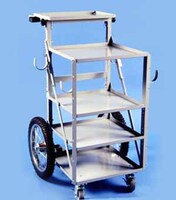 In addition to needing the right personnel, the achievement of good Production Sound requires having the right tools. Don't leave the choice of equipment up to others. The Mixer must always assume responsibility for the selection and preparation of the equipment package.
In addition to needing the right personnel, the achievement of good Production Sound requires having the right tools. Don't leave the choice of equipment up to others. The Mixer must always assume responsibility for the selection and preparation of the equipment package.
If If arranging for equipment is left up to the production company, they will inevitably only order what they feel is economically essential. Since the people who might be ordering the equipment are probably not experienced sound mixers, that means you can almost certainly expect to be lacking a few items that are essential.
Similarly, if you are putting together your own package and ask the production company what you will need, they might also lead you astray. Ask anyway -- sometimes the information that they give you is useful, but plan for contingencies.
For instance, I once mixed an automobile commercial where they wanted me to record a few lines that the storyboard indicated were to take place in an office interior. Easy enough. Most of the commercial consisted of exterior drive-bys of the car -- no sound. So, I sat around at the base camp that had been set up in an outdoor parking lot, while the camera crew photographed the running car shots.
When it seemed like the car shots were nearing completion, I inquired as to where the office set was where we would be shooting the rest of the commercial. A Production Assistant pointed me to behind one of the trailers. There -- smack in the middle of this noisy, windy parking lot -- a crew was erecting three wall flats and some black drapes... an open air exterior set made up to look like an interior!
Had I originally trusted the production company and the storyboards, I might only have come equipped with a complement of interior microphones. However, experience has taught me to always pack as much equipment as I can transport.
My boomman and I rigged our exterior shotgun mic and heavy duty windscreen, and we did the scene outdoors with little problem. The framing was tight enough that we were able to close mic the scene so that traffic noise was not audible.
Moral of the story: Always be prepared.
Don’t scrimp. Go with the best.
Proper equipment means having the best that is available to get the job done. If you cannot afford to own it, then rent it!
Use high quality microphones.
Choose the highest quality microphones that you can, such as the “industry standard” condenser shotguns from Audio Technica, Sennheiser, Sanken, Schoeps, and Neumann.
In contrast, I would not choose as my first choice in production microphones any of the fine electret condenser systems on the market, such as the Sennheiser K6/ME66 or the Audio Technica AT8035. Mind you, these are absolutely excellent microphones for the money. They serve well as reliable back-ups, or for low budget applications such as university film departments.
But compared to the (more expensive) condenser microphones, the electret condensers currently on the market do not offer anywhere near the same exceptional reach and sensitivity. Although the sound from the electrets is comparable to the better mics when used at short range, if you have to increase the distance (such as to accommodate wider framing) the relative crispness and isolation of the dialogue will diminish noticeably.
Recording dialogue on the set is very difficult due to the constraints of camera and lighting. Better microphones are worth the difference!
Also, do not think that any one microphone will do it all. Just as the camera requires different focal length lenses for different applications -- there are different microphones for different situations.
The Learn Production Sound section on this website (see left-side navigation bar) covers the selection and application of microphones in detail.
Mixing panels are a must!
Another item that most budget conscious beginners tend to overlook is the value of a good mixing panel. Even if you are only going to be using one microphone at a time, the mixing panel is an indispensable tool. It provides the soundman with subtle control over the input at all times. Having this means of controlling (riding gain) on the input makes a major difference, especially when working with recorders and camcorders that only offer tiny tweaking knobs for microphone input.
